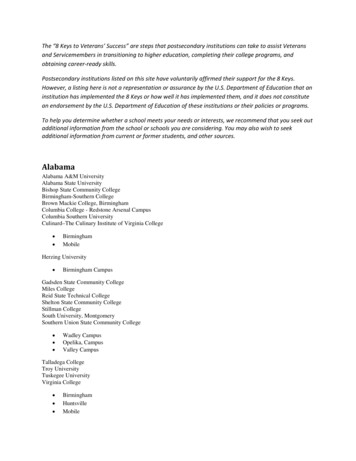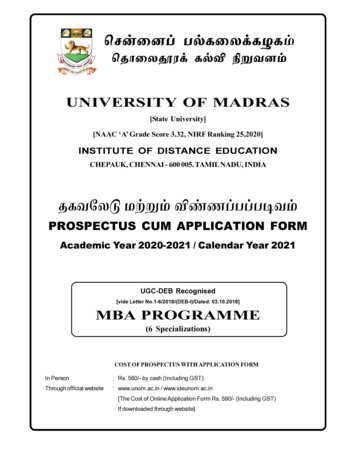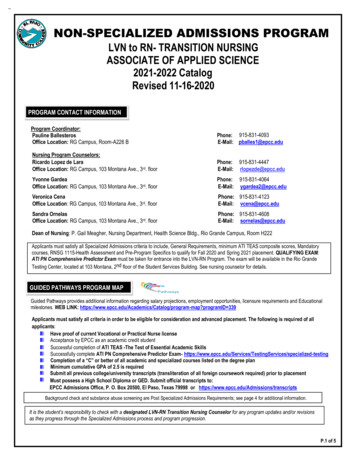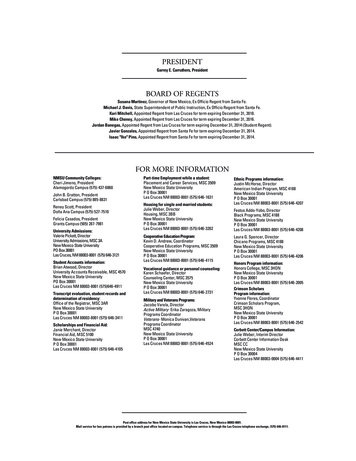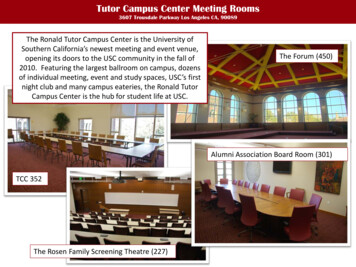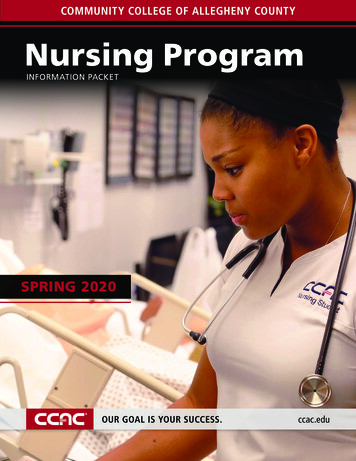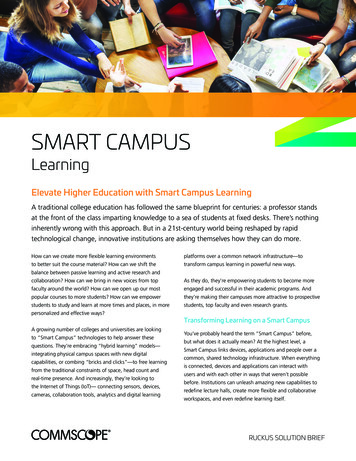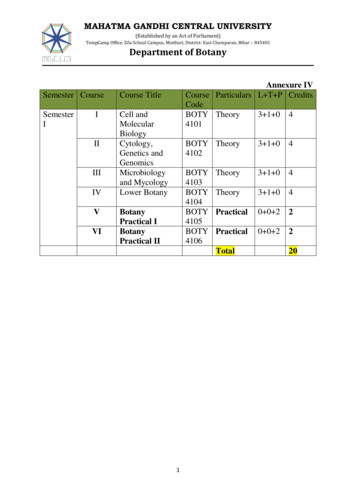
Transcription
MAHATMA GANDHI CENTRAL UNIVERSITY(Established by an Act of Parliament)TempCamp Office, Zila School Campus, Motihari, District: East Champaran, Bihar – 845401Department of BotanySemester CourseCourse TitleSemesterICell andMolecularBiologyCytology,Genetics andGenomicsMicrobiologyand MycologyLower BotanyIIIIIIIVVVIAnnexure IVCourse Particulars L T P CreditsCodeBOTY Theory3 1 0 44101BotanyPractical IBotanyPractical IIBOTY Theory41023 1 04BOTY4103BOTY4104BOTY4105BOTY4106Theory3 1 04Theory3 1 04Practical0 0 22Practical0 0 22Total120
MAHATMA GANDHI CENTRAL UNIVERSITY(Established by an Act of Parliament)TempCamp Office, Zila School Campus, Motihari, District: East Champaran, Bihar – 845401Department of BotanyCORE COURSE ICOURSE TITLE: Cell and Molecular BiologyCOURSE CODE: BOTY 4101Credits: Theory-4UNIT 1Cell components and their functionsThe cell: Structure of prokaryotic and eukaryotic cells.Cell wall and plasma membrane: Structure, composition and function of plantcell wall. Origin, evolution and composition of biological membranes;Membrane transport – Passive, active and facilitated transport, endocytosis andexocytosisUNIT 2Cytoskeleton: Role and structure of microtubules and microfilaments.Endomembrane system and peroxisomes:Endoplasmic Reticulum – Structure, targeting and insertion of proteins in theER, protein folding, processing and export; Smooth ER and its role, ER stress.Golgi Apparatus – organization, protein glycosylation, protein sorting andexport from Golgi Apparatus; the vesicular transport: secretory and endocyticmechanism, Lysosomes structure and function; Peroxisome: The role ofperoxisome in plant metabolism, its genesis, and its types.Ribosome - Ribosomes, structure, functional domain and subunit assembly,Chloroplast and mitochondria: Structure, function and genome organization;Function; Semiautonomous nature of mitochondria and chloroplast, targetingand sorting of protein.Nucleus: Structure-nuclear envelope, nuclear pore complex, nuclear lamina,molecular organization of chromatin; nucleolus, trafficking between nucleusand cytoplasm.UNIT 3Cell divisionEukaryotic cell cycle, mitosis: karyokinesis and cytokinesis, meiosis: variousstages of meiosis, significance of crossing over, significance of irregularmeiosis; Regulation of cell cycle- check points, role of protein kinases.Gene and genome: Fine structure of gene, genome organization in prokaryotesand eukaryotes, transfer of genes between nucleus and organelles. DNA and2
MAHATMA GANDHI CENTRAL UNIVERSITY(Established by an Act of Parliament)TempCamp Office, Zila School Campus, Motihari, District: East Champaran, Bihar – 845401Department of BotanyRNA as genetic material, Mechanism and regulation of DNA Replication inprokaryote and eukaryote, Recombination mechanism and types, andTransposition: prokaryotic and eukaryotic transposon, retrotransposon.UNIT 4Transcription: Transcription unit, cistrons, promoter architecture, regulatorysequences, enhancers and repressor: their mechanism of action, transcriptionmechanism- RNA polymerases, transcription factors, Post Transcription generegulation: Introns, RNA splicing, alternative splicing, RNA stability - capstructure and function, polyadenylation, PTGS, Transcription mechanism ofrRNA and tRNA, RNA degradation. Gene regulation in bacteria: operonsystem, Positive regulation, negative regulation: lac operon, tryptophan operon,Histidine operon, Ara operonUNIT 5Translation: mechanism of translation in eukaryotes and prokaryotes,Genetic code: Deciphering of the codons, reading frame of a sequence,degeneracy of the genetic code, Wobble hypothesis, variations to the standardgenetic code. translational and post translational regulation: posttranslationalmodifications (Proteolytic cleavage, covalent modifications, glycosylation ofproteins, disulfide bond formation). Inhibitors of protein biosynthesis, Co- andpost-translational protein traslocation; chaperones and protein folding, ProteindegradationSUGGESTED READINGS:1. Alberts B, Johnson A, Lewis J, Raff Martin, Roberts K and Walter P. (2007)Molecular Biology of the Cell. Garland Publ., New York.2. Bonifacino JS, Dasso M, Harford JB, Liipincott-Schwartz J and YamadaKM. (2004) Short Protocols in Cell Biology. John Wiley & Sons, NewJersey.3. Bregman AA (1987) Laboratory Investigations in Cell Biology. John Wiley& Sons, New York.4. Hawes C and Satiat-Jeunemaitre B (2001) Plant Cell Biology: PracticalApproach. Oxford University Press, Oxford.5. Hirt RP and Horner DS (2004) Organelles, Genomes and EukaryotePhylogeny: An evolutionary synthesis in the age of genomics. CRC Press.3
MAHATMA GANDHI CENTRAL UNIVERSITY(Established by an Act of Parliament)TempCamp Office, Zila School Campus, Motihari, District: East Champaran, Bihar – 845401Department of Botany6. Lodisch H, Berk A, Kaiser CA, Krieger M, Scott MP, Bretscher A, Ploegh Hand Matsudaire P (2008) Molecular Cell Biology. WH Freeman & Co., NewYork.7. Ruzin SE (1999) Plant Microtechnique and Microscopy. Oxford Univ. Press,Oxford.8. Wischnitzer S. (1989) Introduction to Electron Microscopy. Pergamon Press,New York.9. Campbell, PN and Smith AD (2011) Biochemistry Illustrated, 4th ed.,Published by Churchill Livingstone10.Tymoczko JL, Berg JM and Stryer L (2012) Biochemistry: A short course,2nd ed., W.H.Freeman11.Berg JM, Tymoczko JL and Stryer L (2011) Biochemistry, W.H.Freemanand Company12.Nelson DL and Cox MM (2008) Lehninger Principles of Biochemistry, 5thEdition., W.H. Freeman and Company.13.Karp, G. (2010). Cell Biology, John Wiley & Sons, U.S.A. 6th edition.14.Hardin, J., Becker, G., Skliensmith, L.J. (2012). Becker’s World of the Cell,Pearson Education Inc. U.S.A. 8th edition.15.Cooper, G.M. and Hausman, R.E. (2009) The Cell: A Molecular Approach.5th edition. ASM Press & Sunderland, Washington, D.C.; SinauerAssociates, MA.16.Becker, W.M., Kleinsmith, L.J., Hardin. J. and Bertoni, G. P. (2009) TheWorld of the Cell. 7th edition. Pearson Benjamin Cummings Publishing, SanFrancisco17.Weaver, R, F , (2008) Molecular biology 5th edition McGraw-Hillpublication.4
MAHATMA GANDHI CENTRAL UNIVERSITY(Established by an Act of Parliament)TempCamp Office, Zila School Campus, Motihari, District: East Champaran, Bihar – 845401Department of BotanyCORE COURSE IICOURSE TITLE: Cytology, Genetics and GenomicsCOURSE CODE: BOTY 4102Credit: Theory-4UNIT 1Mendelian and Non-Mendelian Inheritance: Mendelian laws ofinheritance/law of segregation and law of inheritance; Gene interactions(Complementary, supplementary, inhibitory, epistatic, additive, duplicate,polygenic interaction and pleiotropic), linkage, cytoplasmic inheritance;Concepts in Population genetics.UNIT 2Prokaryotic and Eukaryotic Genetics: Recombination in viruses and bacteria(transformation, conjugation and transduction); fungal genetics – mating typesand genetic exchange, heterokaryosis, parasexual cycle.Gene Mapping: Basic concepts, gene maps, correlation of genetic and physicalmaps, molecular markers and construction of linkage maps; Molecularmechanism of recombination; QTL mapping, Gene mapping in prokaryotes.Mutation: Basic concept, spontaneous and induced mutations, allele theory,physical and chemical mutagens.UNIT 3Chromatin Organization, assembly and replication: Nucleosome and higherorder organization of chromatin, conformational changes in chromatin andgenetic activity, assembly/deassembly of nucleosomes during chromatinreplication, centromere and telomere; Chromosome banding patterns: Lineardifferentiation of chromosome segments, types of chromosome banding, uses ofchromosome banding in cytogenetics, Chromosome engineering: transfer ofgene through individual chromosome, alien addition and substitution lines;characterization and utilitySex determination in plants-mechanisms, sex chromosomes;5
MAHATMA GANDHI CENTRAL UNIVERSITY(Established by an Act of Parliament)TempCamp Office, Zila School Campus, Motihari, District: East Champaran, Bihar – 845401Department of BotanyChromosomal aberrations: Duplications, deficiencies/deletions, inversions,interchanges/translocations; Role of chromosomal aberrations in crop evolutionPloidy changes: Haploids, polyploids and aneuploids; Genome analysis in cropplants;UNIT 4Epigenetics: Basic concepts and scope, chromatin remodelling histonemodifications, methylation, epialleles; their inheritance and role in regulation.Techniques for studying epigenetic mechanisms (immunoprecipitation- ChiP,Chip-Seq)UNIT 5Genomics: Concepts Genome and Genomics, genomes sequencing, genomicdatabases; Physical Mapping of DNA, Restriction site mapping, hybridizationmapping. Genome size and C-value paradox, repetitive DNA, split genes,overlapping genes, reverse genetics, genome editing tools (ZFNs, TALENs,CRISPR/Cas9)SUGGESTED READINGS:1. A. K. Sharma and A. Sharma. 1990. Chromosome techniques.Butterworths.1990 Ed2. Ram J Singh (2016), Plant Cytogenetics, third edition, C R C press.3. Ram J Singh (2017), Practical manuals of plant cytogenetics, C R C Press.4. Brown, T.A. (1999). Genomes. BIOS Scientific Publishers limited, UK.5. Gardener, E.J., Simsons, M.J., and Sinustad, D.P. (1991). Principles ofGenetics. John Wiley Sons Inc., New York.6. Griffiths, A.J.F., Miller, J.H., Suzuki, D.T., Lewontin, R.C., and Gelbart,W.M. (1993). An Introduction to Genetic Analysis. Freeman and Comapany,USA.7. Hawley R.S. and Walker, M. Y. (2003) Advanced Genetics analysis-Findingmeaning inGenome. Blackwell Publishing, USA.8. Klug W. S. and Cummings, M. R. (1997). Concepts of Genetics. PrinticeHall International,Inc.9. J E Krebs, E S Goldstein, S T Kilpatrick Lewin’s gene (2017). Gene XII.Oxford University Press, New York.6
MAHATMA GANDHI CENTRAL UNIVERSITY(Established by an Act of Parliament)TempCamp Office, Zila School Campus, Motihari, District: East Champaran, Bihar – 845401Department of Botany10.Schulz-Schaeffer, J. (1980). Cytogenetics of Plants, Animals and Human.SpingerVerlag,New York.11.Strickberger, M.W. (2001). Genetics. Prentice-Hall, Inc., Englewood Cliffs,N. Jersey.12.Smith, J. M. (1998). Evolutionary Genetics. Oxford University Press, NewYork.13.Snustab, D. P., Simmons, M. J. and Jenkins, J. B. (1997). Principles ofGenetics, John Wileyand Sons, Inc., New York.14.Hartl, D. L. and Ruvolo, M. (2012). Genetics, Analysis of Genes andGenomes. 8th Edition.Jones and Bartlet, Ontario.7
MAHATMA GANDHI CENTRAL UNIVERSITY(Established by an Act of Parliament)TempCamp Office, Zila School Campus, Motihari, District: East Champaran, Bihar – 845401Department of BotanyCORE COURSE IIICourse Title: Microbiology and MycologyCOURSE CODE: BOTY 4103Credit: Theory-4UNIT 1Viruses: Origin and evolution of microorganisms; Viruses: morphology,architecture, classification, transmission and genetics of viruses, Economicimportance of viruses; General account of Prion and ViroidUNIT 2Prokaryotes: Ultrastructure, reproduction and economic importance ofMycoplasma, Phytoplasma, Cynobacteria, Archaeaobacteria, Eubacteria andActinomycetes.UNIT 3Fungi: Classification and Phylogeny of fungi. Economic importance of Fungi.Life cycle of representative of each division of Fungi: phytopthora, Rhizopus,Penicillium, Puccinia, and Fusarium.UNIT 4Mycorrhiza: Ectomycorrhiza, Endomycorrhiza and their significancePlant growth promoting bacteria: Phosphate solubilizing bacteria (PSB);Plant growth-promoting rhizobacteria (PGPR); Consortium of Agriculturallyimportant microbes; Bioremediation; Bacteria as bio-control agentUNIT 5Plant Disease: Pathogenesis, Role of enzymes and toxins in plant disease; Plantdefence against pathogens; List of major plant diseases caused by virus,phytoplasma, bacteria and fungi; Diagnosis of plant diseases, Management ofplant diseasesSUGGESTED READINGS1.2.3.Bergey’s Manual of Systematic Bacteriology. Second Edition. Springer.Boyd, R. F. 1984. General Microbiology. Times Mirror Publishers, NewDelhi.Pelczar, M. J., Chau, E. C. G. and Krieg, N. R. 1993.Microbiology conceptsand application.McGraw Hill, New Delhi.8
MAHATMA GANDHI CENTRAL UNIVERSITY(Established by an Act of Parliament)TempCamp Office, Zila School Campus, Motihari, District: East Champaran, Bihar – 845401Department of Botany4.5.6.7.Wiley JM, Sherwood LM and Woolverton CJ. (2013) Prescott’sMicrobiology. 9th Edition. McGraw Hill InternationalAlexopoulus, C.J., Mims. C.W. and Blackwel, M. 1996. IntroductoryMycology, John Wiley & Sons Ind.Dube, H. S. 2013. An introduction of Fungi. Scientific Publishers. India.Mehrotra, R.S. and Aneja, R.S. 1998. An Introduction to Mycology, NewAge Intermediate Press.9
MAHATMA GANDHI CENTRAL UNIVERSITY(Established by an Act of Parliament)TempCamp Office, Zila School Campus, Motihari, District: East Champaran, Bihar – 845401Department of BotanyCORE COURSE IVCOURSE TITLE: Lower BotanyCOURSE CODE: BOTY 4104UNIT 1Phycology: Algae in diversified habitats; thallus organization; reproduction;and classification of algae. Salient features of Protochlorophyta, Chlorophyta,Charophyta, Xanthophyta, Bacillariophyta, Phaeophyta and RhodophytaUNIT 2Algal blooms, algal biofertilizers; algae as food, source of phycocolloids, feedand uses in industry; Lichen – Thallus structure, reproduction and economicimportance.UNIT 3Bryophytes: Features of Bryophytes, Classification and Alternation ofgeneration in Bryophytes; A general account and phylogeny of Marchantiales,Jungermanniales, Anthocerotales, Sphagnales, Funariales and Polytrichales;Economical importance of Bryophytes.UNIT 4Pteridophytes: Salient features of Psilopsida, Lycopsida, Sphenopsida andPteropsida; Structure and Evolution of Stelar System in Pteridophytes;Evolution of Sporophytes, Alternation of generation, Natural and Inducedimplications of Apogamy and Apospory, Heterospory and Seed Habit;Economic importance of Pteridophytes.UNIT 5Gymnosperms: salient features, Classification; A general account of structure,reproduction and evolutionary relationships of Progymnosperms,Cycadofilicales, Cycadeoidales, Glossopteridales, Pentoxylales, Cycadales,Cordaitales, Coniferales, Ginkgoales, Taxales, Ephedrales, Welwitchiales,Gnetales. Economic Importance of GymnospermsSUGGESTED READINGS1.Kumar, H. D. 1988. Introductory Phycology. East-West Press Ltd., NewDelhi.10
MAHATMA GANDHI CENTRAL UNIVERSITY(Established by an Act of Parliament)TempCamp Office, Zila School Campus, Motihari, District: East Champaran, Bihar – 845401Department of BotanyRound, F. E. 1986. The Biology of Algae. Cambridge University Press,Cambridge.3. Morris, I. 1986. An Introduction to the Algae. Cambridge University Press,U.K.4. Morris, I.1986. An Introduction to the Algae. Cambridge University Press,U.K.5. Parihar, N.S. 1991. Bryophyta. Central Book Depot, Allahabad.6. Chopra, R.N. and P. K. Kumra. Biology of Bryophytes. Wiley Eastern Ltd.,New Delhi, 1988.7. Dyer, A. F. and J. G. Duckett.(Eds.). The Experimental Biology ofBryophytes. Academic press, London, 1984.8. Goffinet, B. and A.J. Shaw. Bryophyte Biology. 2 nd Ed. Cambridge Univ.Press, Cambridge, 2009.9. Parihar, N.S. 1996. Biology and Morphology of Pteridophytes, Central BookDepot, Allahabad.10. Puri, P. 1980, Bryophytes. Atma Ram & Sons, Delhi.11. Round, F.E. 1986. The Biology of Algae. Cambridge University Press,Cambridge.12. Bhatnagar, S.P. and Moitra, A. 1996. Gymnosperm New Age Internationalpvt. Ltd., NewDelhi.13. Sunderrajan, S.2007. Introduction to pteridophyta, New Age InternationalPublishers, New Delhi.2.11
MAHATMA GANDHI CENTRAL UNIVERSITY(Established by an Act of Parliament)TempCamp Office, Zila School Campus, Motihari, District: East Champaran, Bihar – 845401Department of BotanyCORE COURSE VCOURSE TITLE: Practical ICOURSE CODE: BOTY4105Credits: Practical-2Cytology, Genetics and Genomics1. Preparation of mitotic and meiotic spreads and analysis of various stagesof cell division (Phlox, Allium and Rhoeo).2. Extraction of genomic DNA from plants by CTAB method.3. Molecular markers: SSR, CAPS, RAPD.4. Analysis of molecular polymorphism in parental lines and derivedmapping population using different types of molecular markers.5. Construction of a linkage map using available data.6. Mutagenesis experiments in E. coli.7. QTL mapping (Theoretical using available data)8. Meiosis and mitotic studies of given plant materials.9. Chromosomal analysis of given plant materials.10.To test the goodness of fit of Data by chi square test.11.Karyotypic analysis and ideogram12.Experiments in Neurospora genetics. Basis of specific ascosporesarrangement in side ascus of Neurospora.Cell and Molecular Biology1. To exemplify the use of phase contrast and fluorescence microscopy inplant biology by studying phase objects and autofluorescent specimens orthose stained with fluorochromes, such as, carbofluoresceindiacetate,aniline blue, calcofluor white, Evans blue and neutral red.2. Isolation of DNA and RNA.3. Visualization of DNA and RNA by electrophoresis.4. Isolation and separation of proteins.5. PCR amplification of selected genes6. Quantification of DNA, RNA and protein by spectrophotometer.7. Isolation and purification of nuclei and their staining with Feulgen stainor DAPI.12
MAHATMA GANDHI CENTRAL UNIVERSITY(Established by an Act of Parliament)TempCamp Office, Zila School Campus, Motihari, District: East Champaran, Bihar – 845401Department of Botany8. Isolation of mitochondria and their visualization with Janus green B andmitotracker.9. Isolation of chloroplasts and determination of number of chlorophyllmolecules per chloroplast.10.In silico analysis (sequence comparison) of mitochondrial and chloroplastgenes for identification of the loci for interspecific discrimination.11.Multiple sequence alignment and ontology based database searches onselected plant cytoskeletal genes to deciphering the molecular phylogenyof cytoskeleton genes.12.Measurement of cell size by the technique of micrometry.13.Counting the cells per unit volume with the help of haemocytometer.(Yeast/pollen grains).*Minimum five or six experiments should be done from each unit13
MAHATMA GANDHI CENTRAL UNIVERSITY(Established by an Act of Parliament)TempCamp Office, Zila School Campus, Motihari, District: East Champaran, Bihar – 845401Department of BotanyCORE COURSE VICOURSE TITLE: Practical IICOURSE CODE: BOTY 4106Credits: Practical-2Microbiology and Mycology1. Morphological and reproductive study of different groups of fungithrough preparation of whole mounts and sections2. Demonstration of phosphate solubilization by bacterial isolates usingPVK medium3. Study of types of root nodules/morphology/anatomical preparationshowing infection zone4. Isolation of fungal and bacterial pathogens from leaves.5. Isolation of fungal and bacterial pathogen from stems fruits and otheraerial plant parts.6. Microscopic preparation and study of pathogenic microbes.7. Detection of plant viruses from infected leaf tissue using ELISA andWestern Blot.8. Screening for antagonism.Lower Botany1. Morphological and reproductive study of different groups of algaethrough preparation of whole mounts and sections2. Morphological and reproductive study of different groups of bryophytesthrough preparation of whole mounts and sections3. Morphological and reproductive study of different groups ofpteridophytes through preparation of whole mounts and sections4. Morphological and reproductive study of different groups ofgymnosperms through preparation of whole mounts and sections14
MAHATMA GANDHI CENTRAL UNIVERSITY(Established by an Act of Parliament)TempCamp Office, Zila School Campus, Motihari, District: East Champaran, Bihar – 845401Department of Courses TitlesCourses Particulars L T PCodeDevelopmental BOTY Theory3 1 0and4201ReproductiveBiologySystematicsBOTY Theory3 1 0and evolution 4202PlantBOTY Theory3 1 0Physiology4203andBiochemistryTechniques in BOTY Theory3 1 BotanyBOTY Practical 0 0 2Practical III4205BotanyBOTY Practical 0 0 2Practical IV4206Seminar IBOTY4207Total15Credits444422121
MAHATMA GANDHI CENTRAL UNIVERSITY(Established by an Act of Parliament)TempCamp Office, Zila School Campus, Motihari, District: East Champaran, Bihar – 845401Department of BotanyCore Course VIICourse Title: Developmental and Reproductive BiologyCourse Code: BOTY 4201Credits: Theory-4UNIT 1Plant development: Shoot apical meristem (SAM) and development of shoot;Cell to cell communication; Regulation of tissue differentiation with specialreference to xylem and phloem, secretory ducts and laticifers; Wooddevelopment in relation to environmental factorsUNIT 2Differentiation and development of plant organs; Pattern formation in plants;Differentiation of epidermis (with special reference to stomata and trichomes)and mesophyll; Programmed cell death, aging and senescence; Root apicalmeristem (RAM) and development of root(s), lateral roots and root hairs;Hormonal control of root developmentUNIT 3Reproduction: Vegetative and sexual reproduction; flower development;genetics of floral organ differentiation; homeotic mutants in Arabidopsis,Antirrhinum and PetuniaMale gametophyte: microsporogenesis, pollen development and geneexpression; pollen germination, pollen tube growth and guidance; pollenstorage; pollen allergy; pollen embryosUNIT 4Female gametophyte: Ovule development; megasporogenesis; organizationand structure of the embryo sac. Pollination, pollen-pistil interaction, selfincompatibility in plants, Double fertilization and in vitro fertilization in plants,Polarity during embryogenesis, Somatic embryogenesisUNIT 5Endosperm development: Early, maturation and desiccation stages;Embryogenesis; Storage proteins of endosperm and embryo; polyembryony;apomixes; Seed development, Fruit development and maturation: biochemistryand molecular biology aspects; Seed dormancy: Importance and types16
MAHATMA GANDHI CENTRAL UNIVERSITY(Established by an Act of Parliament)TempCamp Office, Zila School Campus, Motihari, District: East Champaran, Bihar – 845401Department of BotanySUGGESTED READING1. Bewley, J. D. and Black, M. 1994. Seeds: Physiology of Development andGermination, Plenum Press, New York.2. Bhojwani, S. S. and Bhatnagar, S. P. 2000. The Embryology of Angiosperms(4th revised and enlarged edition), Vikas Publishing House, New Delhi.3. Burgess, J. 1985. An Introduction to Plant Cell Development. CambridgeUniversity Press, Cambridge.4. Fahn, A. 1982. Plant Anatomy (3rd edition), Pergamon Press, Oxford.5. Fosket, D. E. 1994. Plant Growth and Development. A Molecular Approach.Academic Press, San Diego.6. Howell, S. H. 1998. Molecular Genetics of Plant Development. CambridgeUniversity Press, Cambridge.7. P. Maheshwari, An introduction to embryology of angiosperms17
MAHATMA GANDHI CENTRAL UNIVERSITY(Established by an Act of Parliament)TempCamp Office, Zila School Campus, Motihari, District: East Champaran, Bihar – 845401Department of BotanyCore Course VIIICourse Title: Systematics and EvolutionCourse Code: BOTY 4202Credits: Theory- 4UNIT 1History of developments in taxonomy: Linnaean to post-Linnaean era; Outlineof classification of Angiosperms; Hutchinson, Takhtajan, Cronquist, merits anddemerits; Systematics- concepts and components; International code ofBotanical Nomenclature; Principles: rules and recommendations; priority;typification; Rules of effective and valid publications; retention and choice ofnames.UNIT 2Taxonomic features, systematic phylogeny and economic importance offamilies: Rananculaceae, Magnoliaceae, Capparidaceae, Combretaceae,Rosaceae, Asteraceae, Apocynaceae, Asclepiadaceae, Convolvulaceae,Scrophulariaceae, Acanthaceae, cucurbitaceae, Bignoniaceae, Lamiaceae,Verbenaceae, Polygonaceae, Euphorbiaceae, Orchidacae, Zingiberaceae,Araceae, Cyperaceae and Poaceae.UNIT 3Numerical taxonomy: Aims and objectives, characters and attributes, OTUs,coding, cluster analysis, merits and demerits; Chemotaxonomy: Role ofphytochemicals in taxonomy; Embryology in relation to taxonomy; Molecularapproaches to plant taxonomy: Application of DNA markers in angiospermtaxonomy; molecular phylogeny.UNIT 4Evolutionary ecology-concepts and principles; Microevolution - theory andconcepts; Species and speciation; Phylogenetic systematics; Macroevolution inferring phylogenies; Diversity and classification of flowering plants.UNIT 5Biological diversity-concepts and applications; Diversity: patterns, indices andapplications, hot spots; herbarium.SUGGESTED READINGS18
MAHATMA GANDHI CENTRAL UNIVERSITY(Established by an Act of Parliament)TempCamp Office, Zila School Campus, Motihari, District: East Champaran, Bihar – 845401Department of BotanyGrant, W. F. 1984. Plant Biosystematics. Academic Press, London.Judd, W. S., Campbell, C. S., Kellogg, E. A., Stevens, P. F. and Donoghue, M.J. 2007. Plant Systematics: A Phylogenetic Approach, 3rd ed. Sinauer.Nordenstam, B., El Gazaly, G. and Kassas, M. 2000. Plant Systematics for 21stCentury. Portlant Press Ltd., London.Radford, A. E. 1986. Fundamentals of Plant Systematics. Harper & RowPublications, USA.Simpson, M. G. 2006. Plant Systematics. Elseiver & Academic Press.Singh, G. 2005. Plant Systematics. Oxford & IBH, New Delhi.Takhtajan, A. L. 1997. Diversity and Classification of Flowering Plants.Columbia University Press, New York.Woodland, D. W. 1991. Contemporary Plant Systematics. Prentice Hall, NewJersey.19
MAHATMA GANDHI CENTRAL UNIVERSITY(Established by an Act of Parliament)TempCamp Office, Zila School Campus, Motihari, District: East Champaran, Bihar – 845401Department of BotanyCORE COURSE IXCOURSE TITLE: Physiology and BiochemistryCOURSE CODE: BOTY 4203Credit: Theory-4UNIT 1Dissociation of Water and biological Buffers; Principles of thermodynamics inbiology, concepts of Bioenergetics.Transport of Water and SoluteSoil water- plant atmosphere continuum; Water absorption by roots, watertransport through the xylem, Transpiration and guttation.Mineral nutrition; essential nutrients deficiency and plant disorder, soils rootsand microbes; Solute transport molecular motors and pumps.UNIT 2Biomolecules: Structure and function of amino acid, Protein, lipid,carbohydrate, nucleotide and nucleic acid and vitaminsEnzymes: origin and evolution of biocatalytic reactions; mechanism of actionof enzyme, enzyme kinetics, enzyme inhibition, regulation of enzymatic activitysignificance of ribozymes; abzymes; artificial enzymes; enzyme technologyUNIT 3Photosynthesis: light reaction, carbon assimilation (C2, C3, C4 and CAMmetabolism), phloem translocation, evolution of electron transport chain; ATPsynthesis.Respiration: Aerobic and anaerobic, carbohydrate metabolism and lipidmetabolism,UNIT 4SIGNAL TRANSDUCTIONSecond messengers, receptors and G-proteins, phospholipid signaling, role ofcyclic nucleotides, calcium-calmodulin cascade, diversity in protein kinases andphosphatases, specific signaling mechanisms and their regulation.Sensory Photobiology:Phytochromes: Structure, function and mechanisms of action.cryptochromes and phototropins: stomatal movement; scotomorphogenesisand photomorphogenesis20
MAHATMA GANDHI CENTRAL UNIVERSITY(Established by an Act of Parliament)TempCamp Office, Zila School Campus, Motihari, District: East Champaran, Bihar – 845401Department of BotanyUNIT 5GROWTH AND DEVELOPEMENTPlant growth regulators (PGR): Concept of PGR as chemical messengers,techniques for detection and quantitation of PGR, classical approaches and useof mutants in understanding PGR actions, hormones in defense against abioticand biotic stresses, synthetic regulatory compounds and their uses.Developmental Biology of Plants: vegetative and flower development. Plantgrowth, development and senescence. Physiological aspect of biotic interactionand abiotic stressTropic Movement in Plants: growth in response to directional stimuli;SUGGESTED READINGS:1. Ainsworth C (2006) Flowering and its Manipulation, Annual PlantReviews, Vol. 20. Blackwell Publishing, Oxford, U.K.2. Buchanan B, Gruissem G and Jones R. (2000) Biochemistry andMolecular Biology ofPlants, American Society of Plant Physiologists,USA.3. Davies P J. (2004) Plant Hormones: Biosynthesis, Signal Transduction,Action. 3rd Edition,Kluwer Academic Publisher, Dordrecht, TheNetherlands.4. Jordan BR. (2006) The Molecular Biology and Biotechnology ofFlowering, 2nd Edition,CAB International, Oxfordshire, U.K.5. Lodish H, Berk A, Kaiser CA and Krieger M. (2008) Molecular CellBiology, 6th Edition,W.H. Freeman and Company, New York, USA.6. Nelson DL and Cox MM. (2004) Lehninger Principles of Biochemistry,4th Edition, W.H.Freeman and Company, New York, USA.7. Taiz L and Zeiger E. (2017) Plant Physiology, 4th Edition, SinauerAssociates Inc.Publishers, Massachusetts, USA.8. Slisburry and Ross, Plant Physiology, 3rd edition, CBS publisher anddistributers.9. Hopkins, W.G, Introduction to plant physiology, 4th edition,21
MAHATMA GANDHI CENTRAL UNIVERSITY(Established by an Act of Parliament)TempCamp Office, Zila School Campus, Motihari, District: East Champaran, Bihar – 845401Department of BotanyCORE COURSE XCOURSE TITLE: Techniques in Plant Science, Biostatistics andBioinformaticsCOURSE CODE: BOTY 4204UNIT 1Microscopic techniques: light microscopy, resolving powers of differentmicroscopes, microscopy for living cells, scanning and transmission electronmicroscopes, confocal microscopy.UNIT 2Fractionation Methods: Centrifugation, Electrophoresis: Paper and les,AtomicAbsorptionSpectroscopy,fluorescence spectroscopy.UNIT 3Radiolabeling techniques: Detection and measurement of different types ofradioisotopes used in biology, incorporation of radioisotopes in biologicaltissues and cells, molecular imaging of radioactive material, safety guidelines.Histochemical and Immunotechniques: Antibody generation, Detection ofmolecules using ELISA, RIA, western blot,immunoprecipitation,fluocytometry and immunofluorescence microscopy, detection of mol
Cell division Eukaryotic cell cycle, mitosis: karyokinesis and cytokinesis, meiosis: various stages of meiosis, significance of crossing over, significance of irregular meiosis; Regulation of cell cycle- check points, role of protein kinases. Gene and genome: Fine structure of gene, genome organization in prokaryotes
